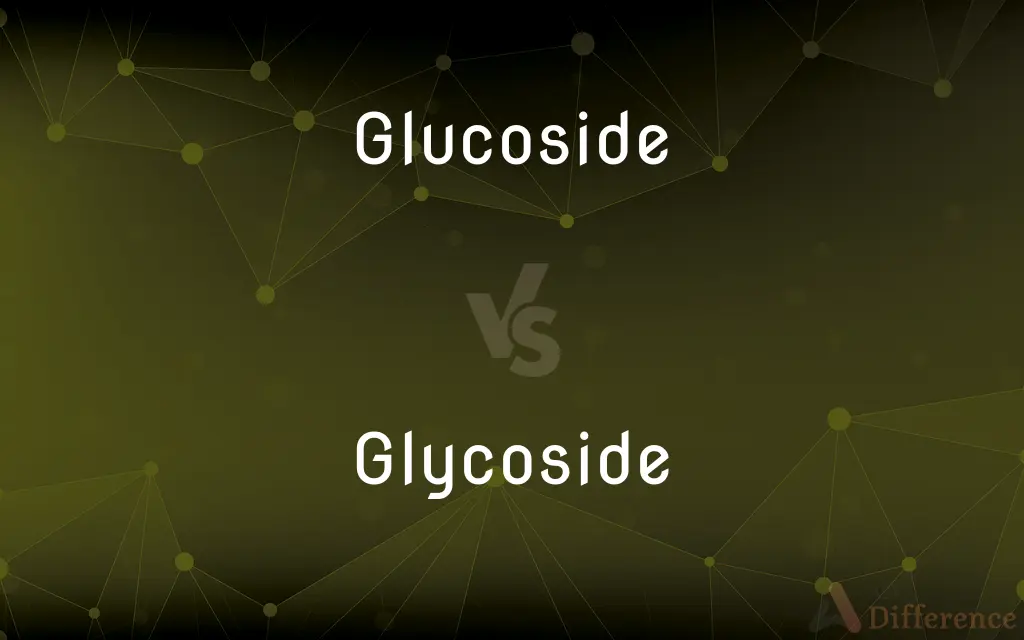Glucoside vs. Glycoside — What's the Difference?
Edited by Tayyaba Rehman — By Fiza Rafique — Updated on September 27, 2023
"Glucoside" is a specific type of "Glycoside" where glucose is the sugar component, whereas "Glycoside" is a general term for compounds with a sugar moiety bonded to another group.

Difference Between Glucoside and Glycoside
Table of Contents
ADVERTISEMENT
Key Differences
A "Glucoside" is inherently a type of "Glycoside," with the key distinction lying in the sugar component. Specifically, in a "Glucoside," glucose is the sugar element, while a "Glycoside" could involve any sugar.
"Glycoside" serves as an umbrella term for compounds formed when a sugar component binds to another functional group through a glycosidic bond. In contrast, "Glucoside" narrows this definition down, specifying that the sugar involved is glucose.
It's imperative to understand that every "Glucoside" is a "Glycoside," but not every "Glycoside" is a "Glucoside." The latter category, "Glycoside," is more expansive, covering a wider range of compounds.
When observing the chemical structures of these compounds, "Glucosides" always feature a glucose unit. "Glycosides," on the other hand, might incorporate other sugars like fructose, galactose, or mannose.
Lastly, both "Glucosides" and "Glycosides" play vital roles in biology and medicine. While "Glucosides" are valued for specific therapeutic properties tied to the glucose component, "Glycosides" as a broader category have a myriad of applications and effects.
ADVERTISEMENT
Comparison Chart
Definition
A specific type of Glycoside with glucose as the sugar component.
A compound formed when a sugar bonds to another functional group.
Sugar Component
Always glucose.
Any sugar (e.g., fructose, galactose, mannose).
Scope
Subset of Glycosides.
Broad category including all sugar-containing compounds.
Example
Amygdalin in almonds.
Salicin in willow bark.
Biological Importance
Known for specific therapeutic properties.
Varied applications and effects across different types.
Compare with Definitions
Glucoside
A Glycoside featuring glucose.
Salicin is a Glucoside found in willow bark.
Glycoside
Compound where a sugar binds to another group.
Glycosides often contribute to the bitter taste in some plant foods.
Glucoside
Glucose-bound molecule via glycosidic linkage.
Some plants produce Glucosides as defense mechanisms against herbivores.
Glycoside
Can involve various sugars, not just glucose.
While all Glucosides are Glycosides, not every Glycoside has glucose.
Glucoside
Naturally occurring compounds in certain plants.
The presence of Glucoside compounds can affect a plant's taste or medicinal properties.
Glycoside
Molecule containing a sugar component linked through a glycosidic bond.
The heart medication digoxin is derived from a Glycoside in foxglove plants.
Glucoside
Sugar-containing compound with glucose as the sugar part.
Consuming bitter almonds introduces a Glucoside called amygdalin into the body.
Glycoside
Biologically active compounds found in various plants.
Many traditional medicines are based on plants rich in Glycosides.
Glucoside
Specific subset of the broader Glycoside category.
While all Glucosides are Glycosides, not all Glycosides are Glucosides.
Glycoside
Essential molecules in biochemistry and pharmacology.
Research on Glycosides has led to the development of several therapeutic agents.
Glucoside
A glucoside is a glycoside that is derived from glucose. Glucosides are common in plants, but rare in animals.
Glycoside
In chemistry, a glycoside is a molecule in which a sugar is bound to another functional group via a glycosidic bond. Glycosides play numerous important roles in living organisms.
Glucoside
A glycoside, the sugar component of which is glucose.
Glycoside
Any of a group of organic compounds, occurring abundantly in plants, that yield a sugar and one or more nonsugar substances on hydrolysis.
Glucoside
(biochemistry) A glycoside that yields glucose after hydrolysis.
Glycoside
A molecule in which a sugar group (the glycone) is bound to a non-sugar group (the corresponding aglycone) by a nitrogen or oxygen atom. Glycosides yield a sugar after undergoing hydrolysis.
Glucoside
One of a large series of amorphous or crystalline substances, occurring very widely distributed in plants, rarely in animals, and regarded as influental agents in the formation and disposition of the sugars. They are frequently of a bitter taste, but, by the action of ferments, or of dilute acids and alkalies, always break down into some characteristic substance (acid, aldehyde, alcohol, phenole, or alkaloid) and glucose (or some other sugar); hence the name. They are of the nature of complex and compound ethers, and ethereal salts of the sugar carbohydrates.
Glycoside
A group of compounds derived from monosaccharides
Glucoside
A glycoside derived from glucose
Common Curiosities
How do Glucosides and Glycosides interact in biology?
Both can serve as biologically active compounds in plants, influencing taste or medicinal properties.
Can Glycosides contain fructose or other sugars?
Yes, while Glucosides specifically contain glucose, Glycosides can involve various sugars.
Why are Glucosides important in pharmacology?
Glucosides possess specific therapeutic properties related to their glucose component, making them valuable in medicine.
How do Glucosides differ structurally from other Glycosides?
Glucosides specifically feature a glucose unit in their chemical structure.
Do all plants contain Glucosides?
No, only certain plants produce Glucosides as part of their chemical makeup.
How does the presence of a Glucoside affect a plant's properties?
Glucosides can influence a plant's taste, medicinal properties, and potential toxicity.
Is every Glycoside also a Glucoside?
No, every Glucoside is a Glycoside, but not vice versa. Glycosides can contain sugars other than glucose.
Are Glucosides found only in plants?
While commonly associated with plants, Glucosides can also occur in other sources or be synthetically produced.
What role do Glycosides play in traditional medicine?
Many traditional remedies are based on plants rich in Glycosides due to their varied biological effects.
What primarily constitutes a Glucoside?
A Glucoside is a specific type of Glycoside where glucose is the sugar component.
Are Glucosides and Glycosides always naturally occurring?
Most commonly, they are found naturally in plants, but they can also be synthetically produced.
Are Glycosides always safe to consume?
Not always. While some Glycosides have therapeutic properties, others can be toxic.
How are Glucosides and Glycosides used in modern medicine?
They serve as active components or precursors in various drugs, exploiting their specific effects.
Do Glucosides and Glycosides have industrial applications?
Yes, apart from their medicinal value, they're used in various industries, including cosmetics and food processing.
Why is it important to differentiate between Glucosides and other Glycosides?
Differentiating helps in understanding their specific biological effects, therapeutic potential, and safety profiles.
Share Your Discovery

Previous Comparison
Comfort vs. Relax
Next Comparison
Dryad vs. HamadryadAuthor Spotlight
Written by
Fiza RafiqueFiza Rafique is a skilled content writer at AskDifference.com, where she meticulously refines and enhances written pieces. Drawing from her vast editorial expertise, Fiza ensures clarity, accuracy, and precision in every article. Passionate about language, she continually seeks to elevate the quality of content for readers worldwide.
Edited by
Tayyaba RehmanTayyaba Rehman is a distinguished writer, currently serving as a primary contributor to askdifference.com. As a researcher in semantics and etymology, Tayyaba's passion for the complexity of languages and their distinctions has found a perfect home on the platform. Tayyaba delves into the intricacies of language, distinguishing between commonly confused words and phrases, thereby providing clarity for readers worldwide.















































